The Go-Getters
There are supposedly two kinds of people in this world: those who do and those who don’t. You’re about to meet a third variety: those who do and get started early. The amazing young people in the profiles to follow are ambitious, intelligent and compassionate, and they’ve translated those winning attributes into action. They also know there’s no time to waste. Their work in the name of the environment has already helped the landscapes and communities they live in, and their efforts continue to change the world for the better. Lucky world. Lucky us.

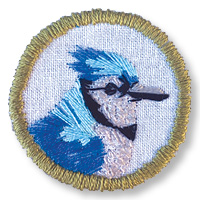
AVIAN ADVOCATE
Sebastian Casarez
age 15
Imagine this scenario: you’re 12 years old, you’re standing in front of a crowd of your peers; and you’re making bird calls. What’s more: You’re hoping that, in a moment, those peers will try making a blue jay call back at you.
These are the types of situations Sebastian Casarez finds himself in. But any inhibitions the Texas native might have about public speaking fly right out the window when he’s talking about birds. “He doesn’t care if he’s in front of 200 or 300 kids,” says Sandra Casarez, Sebastian’s mom. She recounts the above event: “I was like, ‘Oh, lord, please make the call back,’ and they were doing it! I was so glad.”
This is nothing new for Sebastian. He’s been sharing birding knowledge across Texas since he was 9 years old, leading birding walks with Travis Audubon’s Young Birders Club and speaking and presenting at birding festivals, libraries, schools and events like the Wildflower Center’s Nature Nights. But his interest in birds developed even earlier, when he set eyes on the book “Bird: The Definitive Visual Guide” at the age of 7. His mother splurged and bought it, and a self-taught birding wunderkind was born. “He’s opened our world,” says Sandra of Sebastian’s effect on her and her husband. “We weren’t officially outdoorsy; now we’re in tall grass up to here [motions to her midthigh] looking for owls,” she explains with a laugh.
His parents aren’t his only encouragers. Dr. Keith Arnold, a professor emeritus at Texas A&M University and author (with Gregory Kennedy) of “Birds of Texas,” has taken Sebastian under his (ahem) wing as a mentee. Not surprisingly, Sebastian wants to pursue a career as an ornithologist, but his current goal is to share his love of birding. “Not only are [birds] graceful creatures,” he says, “they eat annoying mosquitoes and help with insect control and plant trees by the seeds they eat.”
Without birds, he says we’d be living in a “treeless, bug-filled area.” But he finds the lack of young birders discouraging: “There could be a nice male painted bunting on a tree and nobody would notice because they’re busy texting or just playing soccer,” he explains, adding in complete earnest, “You know how kids are.”
In 2017, he created the Texas Blue Jay Project (named after his favorite bird) “to encourage Texans to go out and explore birds in their back yards, city and state parks.” The website (and blog) asks people to take a pledge to begin birding; so far, about 1,000 people have done so.
Sebastian also gathers and distributes donated field guides to low income kids; organizations such as Marbridge, a community of adults with intellectual disabilities south of Austin; and to schools without nature programs. In 2015, he received a community collaboration award from CiNCA (Children in Nature Collaborative of Austin) in honor of his efforts. “I believe if we start educating kids about birds early and about how important their habitats are we can not only build awareness for bird habitats but create future bird conservationists,” says Sebastian. “It’s what we need.”
That need includes native habitat preservation, which he is sure to touch on: “I talk about what native plants to plant in your yard to attract birds,” he says, noting that “hummingbirds like Turk’s cap and trumpet creepers.” He’s also observed that the purple sage (Leucophyllum frutescens), oak trees (Quercus spp.) and Maximilian sunflowers (Helianthus maximiliani) at his family’s home in Hutto, Texas, “get all the birds in our yard.”
Birding has its personal benefits, too: “It helps when you’re stressing out,” he says. “You can just go out and look at birds. It’s peaceful.” He feels this is crucial for young people. “Most kids just want to stay home and look at their phones and the internet and play video games,” he says. But he likens birding to a real-life video game, describing it as a gratifying seek-and-find activity. As if on cue, he spots a cardinal couple in the Wildflower Center’s Courtyard. “I think they want to be a part of our conversation,” he remarks. Thanks to Sebastian, they are — and they’ll be part of many conversations to come. – Amy McCullough
WEB EXTRAS
Take the pledge and stay informed about The Texas Blue Jay Project
Watch a video about Sebastian’s 2015 E. Lee Walker Award
See him interviewed and hear him do a Wilson’s snipe call
PHOTO Sandra Casarez

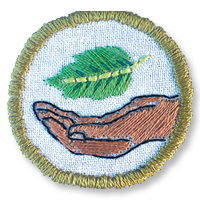
GREEN GURU
Paige Johnson
age 19
Paige Johnson sees plants — specifically flowers — as a metaphor for life. And the most important part of that life process is blossoming. The San Antonio native, currently a junior at Clark Atlanta University, adopted the phrase “blossom effect” as her personal platform because she’s all about growth: figurative and literal. And the way she sees things, you can’t grow personally without green space on your radar.
That’s why she was determined to bring a garden to her college campus. “I’m a big fan of meditation, yoga, greenery, hiking,” she explains. “Those are some of my safest places — where I can really breathe, where my mind is open.” She wasn’t seeing enough opportunity for that at CAU, so she helped plan and plant a garden outside of the student center last spring (see below). It’s her way of saying to fellow students, “Here, try this. Maybe it’ll help you destress and breathe and just relax.”
Johnson developed the garden initiative during her tenure as Miss Sophomore 2017-18 (part of Miss Clark Atlanta’s “Royal Court”). It took a semester and a half to plan and secure funding for the plot, and she wasn’t able to choose the plants (that fell under the purview of the university grounds maintenance crew she coordinated with). “It wasn’t the garden that I wanted,” she admits. “It didn’t have any … wildflowers, but I’ll take what can get.” Johnson, a mass media arts major, did get to pick out and dedicate a bench and work on the garden design. (She also volunteers with her school’s Living Green Club, a nonprofit that participates in climate change activism as well as community cleanup and sustainable living efforts.)
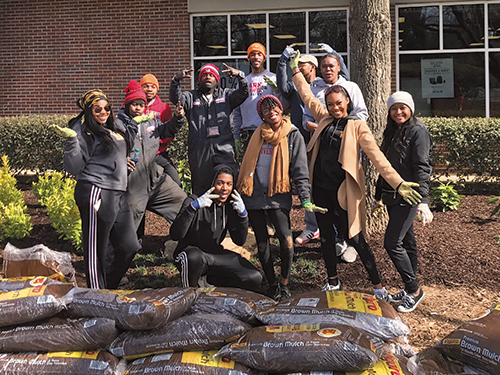 The exuberant 19-year-old credits her affection for the natural world to family. Her dad’s green thumb and her grandmother’s love and cultivation of hibiscus trees (Hibiscus spp.) got her started, but it was the few years she lived in Ohio when the versatility of nature and its potential for increasing wellness “really clicked for me,” she says. “There were so many hiking trails and nature preserves. It was different every single time I went out. That’s when I realized I can really take advantage of these places: I can come here and journal, do yoga, meditate; I can come here and have fun with friends.”
The exuberant 19-year-old credits her affection for the natural world to family. Her dad’s green thumb and her grandmother’s love and cultivation of hibiscus trees (Hibiscus spp.) got her started, but it was the few years she lived in Ohio when the versatility of nature and its potential for increasing wellness “really clicked for me,” she says. “There were so many hiking trails and nature preserves. It was different every single time I went out. That’s when I realized I can really take advantage of these places: I can come here and journal, do yoga, meditate; I can come here and have fun with friends.”
She’s interested in passing that legacy on. As a summer intern with the Greening Youth Foundation — which seeks to create pathways to conservation careers for diverse, underserved and underrepresented youth — she helped kids ages 2 to 15 learn to value the environment. Johnson helped plant a community garden at W. W. Woolfolk Boys & Girls Club in Atlanta’s West End last summer, but her main job was leading educational activities. Project Manager Christine Louis-Jacques says Paige “connected really well and was great at getting kids engaged,” especially a group of seventh-grade girls: “Seeing another young woman who’s really into the environment got them to open up and actually get into the games and activities,” says Louis-Jacques. Johnson describes her work with GYF as “very purposeful.”
“I think all kids are interested in learning about the environment,” she says. “At that age, they’re thinking about themselves, [asking] ‘What can I do to help nature, to preserve this, to make the world a greater place?’ They see the importance and are willing to help.” Johnson believes fostering that interest is key to a healthy future, but she sees real-world challenges, including a preoccupation with technology. “We had to collect phones from students,” she says of her summer internship. She’s concerned about her own cohort, as well: “We’re so back to back to back doing stuff [as college students] that we don’t get that time to be outdoors.”
Which all leads back to what Johnson calls the “blossom effect.” For her, “blossom” means “to mature or develop in a promising or healthy way.” It encompasses her belief that healthy internal development allows us to reach outward with positivity and wellness — to bloom eventually — and that requires time in nature. “We have to go out. We have to be outside,” she urges. It’s her personal mantra, one she’s eager to share with the children she teaches, her peers and you. – Amy McCullough
WEB EXTRAS
Read an interview with Paige
Learn more about the Greening Youth Foundation
PHOTOS Tré Hazelwood/Trillex Photography (portrait) and courtesy of Paige Johnson (student garden)
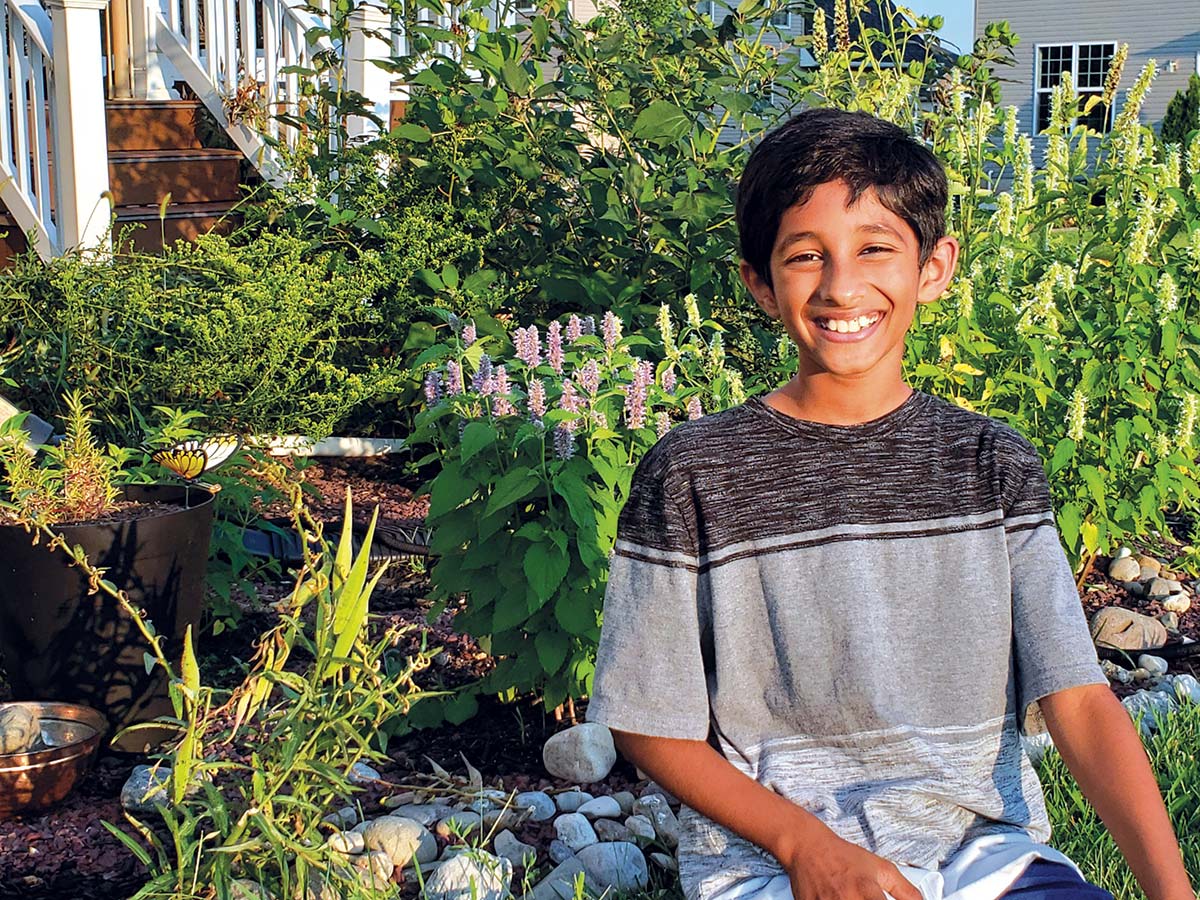
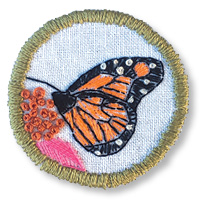
POLLINATOR-PLANT POWERHOUSE
Kedar Narayan
age 10
Try to think of an adult who has done more than one of the following: developed an app, delivered a TED Talk, started their own motivational YouTube channel, made a stop-motion film, become CEO of their own environmentally minded company. Tough, right? Well, the seemingly unstoppable Kedar Narayan accomplished all of the above and more before aging into double digits. Did we mention that he’s also transformed a good chunk of his family’s yard in Pennsylvania into a native plant garden/pollinator paradise and is an activist encouraging others to follow suit? Everything about this kiddo is extra.
So how does one go from playing video games to making them — from coloring butterflies with crayons to researching and cultivating a garden that attracts monarchs, all at such a tender age? “When I was five years old, I liked to play video games. One day my mom said, ‘Why don’t you learn to code and make your own video games?’” explains Kedar. So, he did. Then he traveled to nearly a dozen fairs teaching others about making video games.
But Kedar is not the kind of kid who ever really calls it “a day.” So he took his coding superpowers and — with encouragement from his computer scientist mom, Anita Narayan, and crafting help from his grandfather — created a 3-D board game so his blind friends could learn to code through tangible shapes. But don’t take our word for it: You can get the full, hyperanimated story direct from a 7-year-old Kedar by watching his TED Talk, “Create Games to Solve Problems.” And honestly, you should. He is an inspiring and delightful speaker.
After making an impact in the coding community, Kedar turned his wide, sparkling eyes to native plant gardening. “I was trying to see what I could do for fun, and I thought about gardening … I just love that it attracts so many pollinators so it feels like you’re in a mini forest. It just feels enchanted,” says Kedar. His mom feels the magic, too: “He was watering the plants today and got so excited following a monarch to the wild columbine where he spotted a caterpillar and a beautiful blue cocoon. This is why we need more kids in the garden.”
Of course, this little gardening/coding ninja did not stop with merely tending some native plants. With help from his area master naturalists and a partnership with National Wildlife Federation, Kedar researched and created an app called “Pollinator for a Pet” that helps anyone of any age learn how to plant a native garden that will attract and support pollinators. He thinks it’s important for adults and parents to learn all they can about conservation and share it with kids so they know why it’s important.
Kedar would like to see everyone replace part (or all!) of their yard space with native plant gardens. To that end, he researches and posts fun, educational videos on his YouTube channel. In addition to learning about white giant hyssop (Agastache micrantha), you can watch the stop-motion short film he made featuring origami critters from his online crafting business, Heart for Wildlife. Kedar uses the site to sell kits so anyone can make pollinator keepsakes out of sustainable paper — and 10 percent of his profits support NWF.
His mother says, jokingly, “He is just a little boy with a big emotional heart that makes him pay too much attention to detail and sometimes gets him in trouble.” So what kind of trouble does Kedar plan to get into next? This year he is working with the local zoo to develop an app that will help volunteers record penguin feedings. After that, “I’d like to cure lung cancer,” he says with a genuine smile. Feel free to smile along with him, take a deep breath, and feel hopeful about a cleaner, greener future forged by the Kedars of the world. – K. Angel Horne
WEB EXTRAS
Watch Kedar’s TEDx Talk
Check out DIY crafts and watch Kedar deliver a spirited speech about orchard mason bees (his favorite)
Download his app on Google Play
Visit Kedar’s YouTube channel
PHOTO Anita Narayan
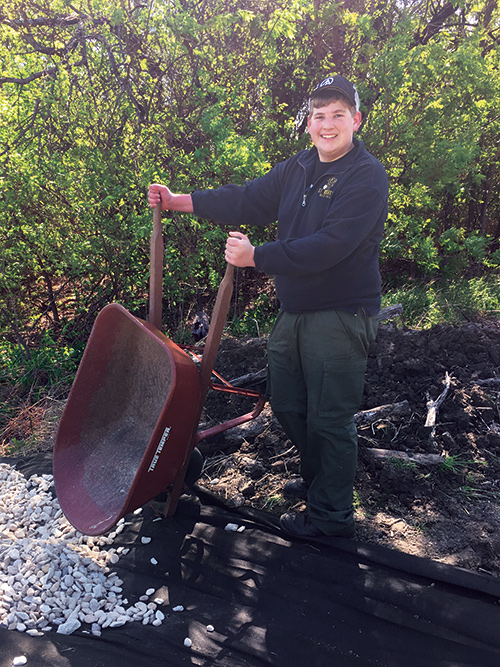

PRAIRIE PROTECTOR
Trevor Burke
age 17
When Trevor Burke was 12 years old, he asked his mom a question no mother is ever ready for: “Mom, can I raise 300 bobwhite quail in your living room?”
More surprising than his question, was her answer: yes.
Nearly six years later, Burke has raised and released thousands of quail — and completed many other conservation projects — in order to help save the Texas Blackland Prairies, the most endangered ecosystem in America.
Burke, a passionate and outspoken Texas native, fell in love with blackland prairies when he was searching for an Eagle Scout project in seventh grade. The landscape’s tall, vibrant grasses and stunning diversity of wildflowers and native animals amazed him. When he found out how endangered the prairie was, Burke knew he had to do something.
Texas Blackland Prairies once covered 12 million acres in a sea of grasses. Since the mid-1800s, urban and agricultural development have taken out swaths of prairie each year, and invasive grasses ravage the 5,000 or so remaining acres. That area is shrinking fast. “That sort of devastation over the past more than 100 years just really hits home to my heart,” says Burke, “and I want to do everything I can to help it.”
Burke got his chance when he started his Eagle Scout project at the Connemara Conservancy in North Texas. Under the guidance of Bob Mione, manager of the conservancy’s Meadow Nature Preserve, Burke developed a plan to restore the prairie there.
First, he would remove invasive species, such as Johnson grass (Sorghum halepense) and Bermudagrass (Cynodon dactylon), and replace them with native species like Indiangrass (Sorghastrum nutans) and big and little bluestem (Andropogon gerardii and Schizachyrium scoparium, respectively). Finally, Burke planned to reintroduce native animal species to the restored habitat — that’s where the quail came in.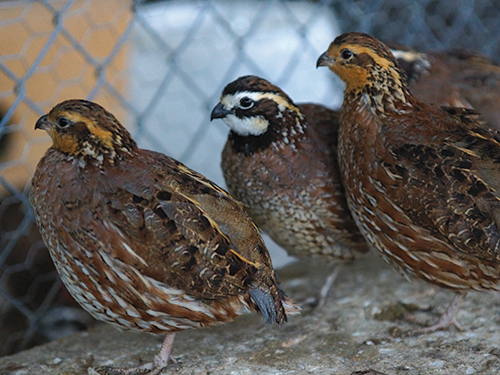
Burke obtained a Texas Game Bird Breeder’s License and set to work. The first clutch of 300 quail (see right), all named Bob, entered the world in an industrial-sized incubator, funded by a grant from Disney’s Friends for Change.
“It’s been a journey,” says Trevor’s mother, Nancy Burke, a litigation attorney. “We had quails in our living room, in our dining room, in our garage, in our backyard.” Despite the excess of feathered houseguests, she says she enjoyed seeing the impact of Burke’s blackland prairie restoration on his personality and leadership skills. “As a mom, it’s been very rewarding to watch Trevor grow and mature through this.”
Mione agrees. “When I first met Trevor it was 2012, and six years later he has matured into a pretty dynamic young man,” says Mione. “He knows what he is doing and has command of the situation, and he is a real pleasure to work with.”
Burke will head to college next year, but for now he’s still working on his blackland prairie plan. And with help from the conservancy, the project will continue into the future.
He leaves readers with this challenge: “The average human lifespan is about 75 years, which calculates out to about 2.3 billion seconds — that’s lot of seconds,” says Burke. “Somewhere along all of those seconds each of us has the capability, power, passion and responsibility to protect our world — not only for our generation, but for generations to come. How are you going to spend those seconds?” – Eva Frederick
WEB EXTRAS
Watch Trevor’s TEDx Talk
Learn more about the Connemara Conservancy
PHOTOS Nancy Burke
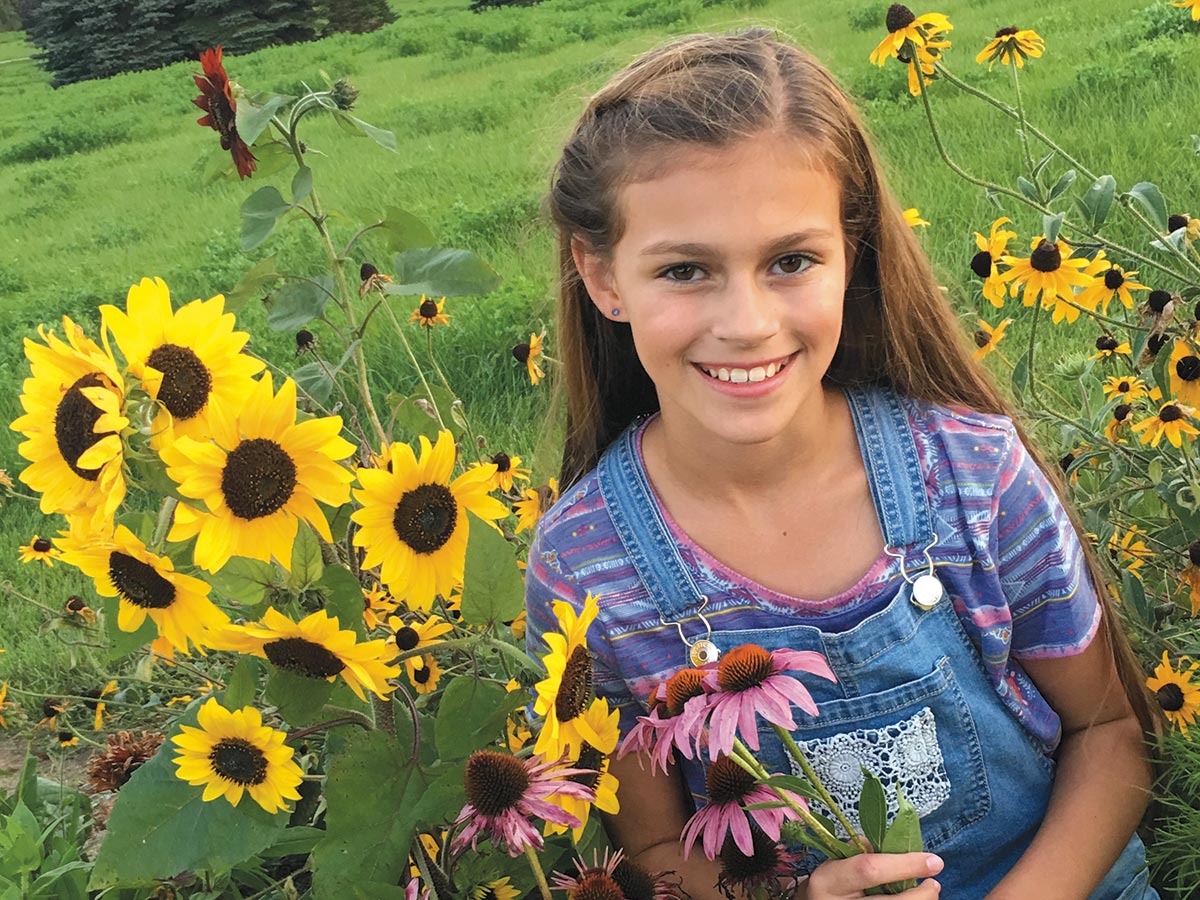
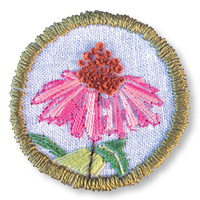
WILDFLOWER WONDER
Zylia Kleinfeldt
age 11
Zylia Kleinfeldt’s first name means “of the forest” — a fitting description for a girl who has worked hard to raise awareness for the wildflowers of her home state, Wisconsin.
At age 11, Kleinfeldt has not only created a petition to change Wisconsin’s state flower in order to protect and publicize a threatened species, but she has also written and illustrated her own book.
Wisconsin’s state flower is the wood violet, a small purple resident of the state’s wet woodland areas. The wood violet is beautiful, but Illinois, New Jersey and Rhode Island also claim violets as their state flower.
When she learned this, Kleinfeldt wanted Wisconsin to have its own special flower, and she knew about another native bloom, the purple coneflower (Echinacea purpurea), that could use a little publicity. “Lots of bees and butterflies like purple coneflowers, and because they are[threatened] I want people to become more aware of them,” says Zylia.
Zylia is shy and soft-spoken, but with the help of her parents, Karyn and Steve Kleinfeldt, she stepped out of her comfort zone and contacted her two state senators last summer. Inspired by her enthusiasm, they created a memo to present to the Wisconsin senate; no moves have been made to change the state flower yet, but Zylia is not giving up and plans to find more support for her idea.
And Zylia shows her passion for wildflowers in another way: Three years ago, she wrote and illustrated “Wildflower Girl,” which won first prize in the second-grade category of the 2015 PBS Kids Writers Contest. Her book tells the story of a lovely, flower-haired child who tends fields of magical blossoms.
Wildflower Girl warns others not to pick the flowers, because “there is a field of flowers in every bloom” — a nod to the amazing reproductive properties of plants. When an old professor, struck by the beauty of the blooms, ignores her warnings and plucks a zinnia, all the flowers in the field die, and he grows a flower bed out of the top of his head. Wildflower Girl helps him solve his problem, and the professor learns his lesson.
The inspiration for Kleinfeldt’s book came partially from her experience gardening with her mother. “Me and my mom always plant wildflowers together, and I think they are really pretty and I really like them,” she says. Kleinfeldt uses mixed media in her floral illustrations, including paint, glitter and real seeds.
Kleinfeldt’s mother, an artist, is glad to encourage and support her daughter, whether by helping her reach out to government officials or providing art supplies for her books. “She really enjoys making stories and writing, so I make sure I encourage her to read and write and also illustrate stories,” says Karyn.
Zylia says Lady Bird Johnson is an inspiration in her work with wildflowers. “In second grade, we had to do a project on an important person in history and I chose her,” she explains. “I had to dress up as her and write a report on her, and I read a book of hers. [I liked] how she wanted wildflowers on the side of highways … I love Lady Bird Johnson!” – Eva Frederick
WEB EXTRA
Read a news story about “Wildflower Girl” (and see some of Zylia’s illustrations)
PHOTO Karyn Kleinfeldt
ALL EMBROIDERY Lisa Gerber

